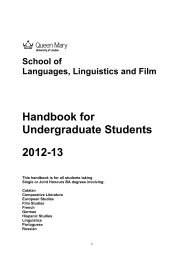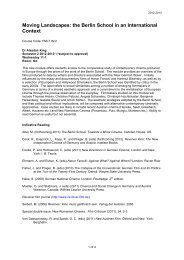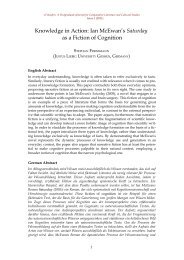Finnegans Wake - Queen Mary, University of London
Finnegans Wake - Queen Mary, University of London
Finnegans Wake - Queen Mary, University of London
Create successful ePaper yourself
Turn your PDF publications into a flip-book with our unique Google optimized e-Paper software.
eTransfers. A Postgraduate eJournal for Comparative Literature and Cultural Studies<br />
Issue 1 (2011)<br />
Let us examine the narrative more closely. According to McHugh, the etymology<br />
<strong>of</strong> the Basque word for orange is “the fruit which was first eaten.” 14 Taken with the<br />
Irish flag we find in “oranges laid to rust upon the green,” this suggests that the Irish<br />
nation is itself in some sense fallen. This biblical imagery is enhanced when we<br />
realise that “devlin first loved livvy” reveals not only a relationship between Dublin<br />
and the River Liffey but the Devil (as a tempting serpent) and Eve. We are even told<br />
that Finn lies like an overgrown “babeling” (Tower <strong>of</strong> Babel). He is symbolised by<br />
the ‘Ш’ rune depicting man’s prone state. Shaun is described as lying in “one foule<br />
stretch” for “ells upon ells,” a Miltonic metaphor reminding <strong>of</strong> Satan lying prostrate,<br />
outcast to the fires <strong>of</strong> Hell. This “fall <strong>of</strong> a once wallstrait oldparr” is repeated<br />
endlessly in all forms <strong>of</strong> HCE from Adam to Shaun.<br />
As statements <strong>of</strong> the recurring “fall” theme, these biblical and national images<br />
suggest that Irish religious and cultural structures have themselves grown out <strong>of</strong> the<br />
underlying structure <strong>of</strong> human being. We learn <strong>of</strong> HCE that “Father Barley […] got<br />
up <strong>of</strong> a morning arley and he met with a plattonem blondes names Hips and Haws”<br />
(FW 257), suggesting how the archetypal man, in his fallen state, is similar to John<br />
Barleycorn, a pagan symbol for the process <strong>of</strong> the barley harvest and brewing <strong>of</strong> beer<br />
and whiskey. The theme <strong>of</strong> Earwicker’s seduction by the two maids (“Hips” and<br />
“Haws”) finds echo here in the process <strong>of</strong> brewing beer. The world <strong>of</strong> the <strong>Wake</strong> is<br />
narratively bound to the fall <strong>of</strong> man. This narrative structure is imbricated into the<br />
very landscape itself.<br />
Fallenness [Verfallenheit] is also an important aspect <strong>of</strong> Dasein, being associated<br />
with its authenticity [Eigentlichkeit]. Indeed, “falling reveals an essential ontological<br />
structure <strong>of</strong> Dasein itself.” 15 Hubert Dreyfus outlines three forms <strong>of</strong> this structure:<br />
absorption, language and reflexivity. 16 Let us examine these. Dasein does not exist as<br />
a subject but is instead already bound up with the world such that it is the clearing-<br />
foundation in which human subjectivity shows up.<br />
14 Roland McHugh, Annotations To <strong>Finnegans</strong> <strong>Wake</strong> (Baltimore: Johns Hopkins <strong>University</strong> Press, 2006),<br />
3.<br />
15 Heidegger, Being and Time, trans. Macquarrie, John & Robinson, Edward (Oxford: Blackwell<br />
Publishing, 2006 [1962]), 224. In the following this source will be quoted in the continuous text as BT.<br />
16 Hubert Dreyfus, Being-in-the-world (Cambridge, Massachusetts Institute <strong>of</strong> Technology, 1991).<br />
8







